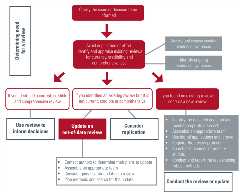Update an out-of-date review
Where you identify reviews that appear out of date, contacting the original author team is useful to determine whether they have plans to undertake an update. Depending on the circumstances, it might be appropriate to either await a planned update, provide support to the existing team, or to create a new team to update the review separately.
Updating an existing review is generally more efficient than starting from scratch with a new review. The decision to update may be influenced by a range of factors such as the likelihood that new research may influence the result or have the potential for impact on health, the degree of certainty of the findings of the existing review, the methods applied, and any awareness you have of other important factors that may not have been sufficiently considered by the original team. Updates may be complete or partial, for example, focusing only on specific PICO characteristics, or may amend the types of studies that are identified and included such as searching for non randomised studies to identify serious harms.
Relevant reading:
Guidance and a checklist to guide the decision on when and how to update a systematic review can be found here. (Garner P, Hopewell S, Chandler J, MacLehose H, Akl E A, Beyene J et al. When and how to update systematic reviews: consensus and checklist BMJ 2016; 354 :i3507)
Download a PDF of 'Resources for researchers considering and conducting COVID-19 evidence syntheses'
View the interactive flow diagram

